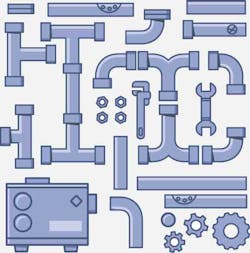This observation is supported by a recent study conducted at a leading chemical company as part of a Six Sigma project that indicated the correct pump size is selected only 10 percent of the time. HI is out to transform this way of thinking with its Pump Systems Matter (PSM) initiative, by focusing on the economics of pumps and pumping systems to unlock the potential for improved system performance and energy efficiency.Correct pump selection is critical for maximizing pump system performance and extending system life. An incorrectly sized pump is inefficient and can be a maintenance nightmare due to premature wear of internal parts. The cost of incorrectly sized pumping systems extends beyond energy bills, as evidenced by the estimated $1 billion spent per year on replacement parts.An oversized pump can also overtax a valve, a pressure-regulating device or the system piping itself, which increases system wear. In addition, noise and vibration caused by excessive flow creates stress on pipe welds and piping supports that can erode pipe walls.Pump conundrumIn the process industries, pumping systems have historically fallen under the fluid handling domain, and are generally not considered in the process control scheme. The pervasive use of pumps in manufacturing frequently leads to conservative pump sizing to ensure that system needs will be met under all conditions. Project engineers generally err on the side of caution by adding more capacity, leading to oversized pumps that result in higher than necessary system operating and maintenance costs.For whatever reason, when it comes to pumping systems, manufacturers frequently purchase solely on initial purchase price, which generally accounts for only 15 percent of lifecycle cost. Energy and maintenance costs, by contrast, account for more than 50 percent of pump lifecycle costs. In energy intensive industries such as chemical and petrochemical, pulp and paper, and metals and mining, the potential for savings in energy and operational costs is significant. A recent survey by the U.S. Department of Energy indicated that pumps represent the greatest opportunity for energy savings for process manufacturers.Perhaps the most powerful tool that the Pump Systems Matter initiative has developed is the free, downloadable Pump System Improvement Modeling Tool (PSIM) for centrifugal and positive displacement pumps. PSIM is a supplier-neutral modeling tool for pump system engineers to better understand the hydraulic behavior of pumping systems through the development of pump-vs.-system curves.Using HI algorithms and drag-and-drop interfaces, PSIM calculates pump energy usage and energy cost over time using Net Present Value concepts. Suitable for existing and new pump installations, PSIM modeling enables users to evaluate a wider range of improvement opportunities, including energy reduction and improved system performance. ARC strongly recommends visiting the Pump Systems Matter Web site at www.pumpsystemsmatter.org to learn more about the initiative and preview the tools that PSM has developed to guide manufacturers in saving energy and improving performance. Further, perform a pumping system audit at your facility to determine if your plant can benefit from improved performance, while at the same time reducing your energy costs. Paula Hollywood, [email protected], is senior analyst, process automation, at ARC Advisory Group Inc., in Dedham, Mass.
About the Author
Sign up for our eNewsletters
Get the latest news and updates

Leaders relevant to this article:
